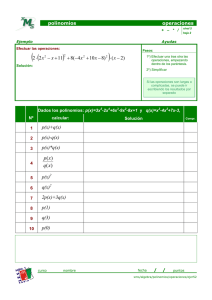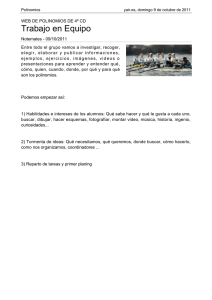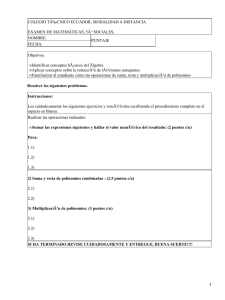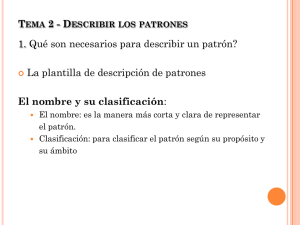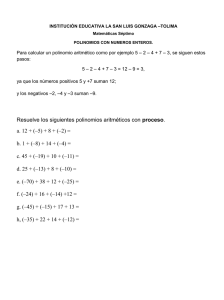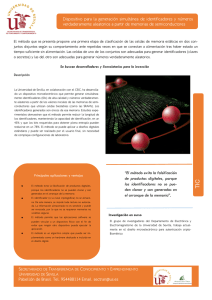resumen completo
Anuncio
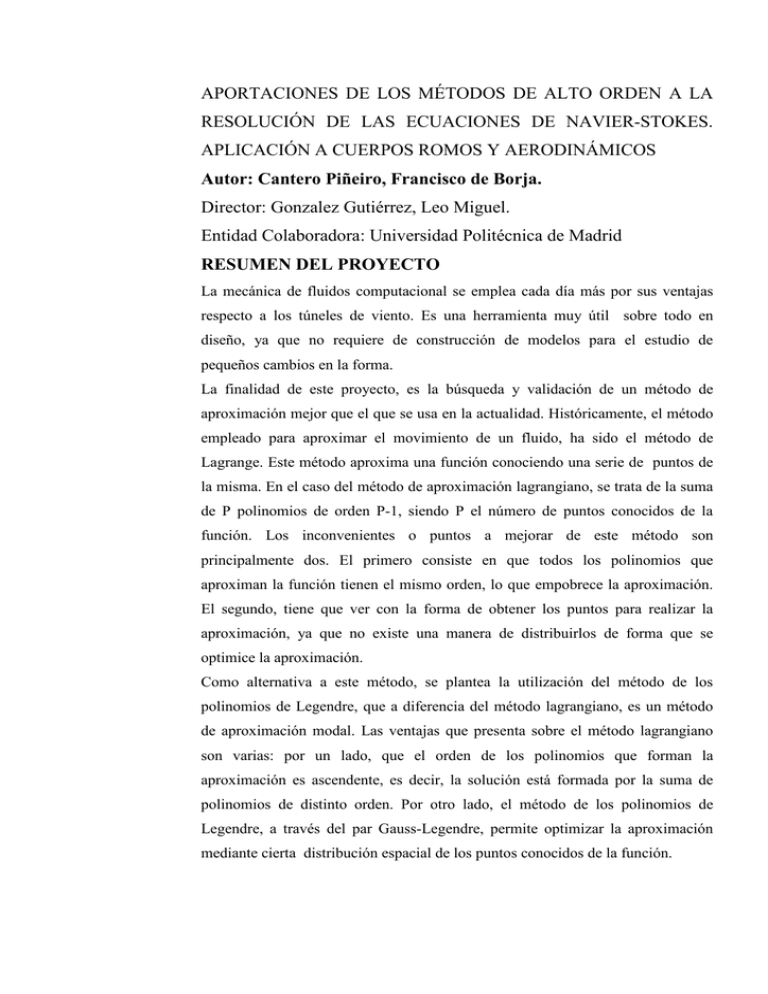
APORTACIONES DE LOS MÉTODOS DE ALTO ORDEN A LA RESOLUCIÓN DE LAS ECUACIONES DE NAVIER-STOKES. APLICACIÓN A CUERPOS ROMOS Y AERODINÁMICOS Autor: Cantero Piñeiro, Francisco de Borja. Director: Gonzalez Gutiérrez, Leo Miguel. Entidad Colaboradora: Universidad Politécnica de Madrid RESUMEN DEL PROYECTO La mecánica de fluidos computacional se emplea cada día más por sus ventajas respecto a los túneles de viento. Es una herramienta muy útil sobre todo en diseño, ya que no requiere de construcción de modelos para el estudio de pequeños cambios en la forma. La finalidad de este proyecto, es la búsqueda y validación de un método de aproximación mejor que el que se usa en la actualidad. Históricamente, el método empleado para aproximar el movimiento de un fluido, ha sido el método de Lagrange. Este método aproxima una función conociendo una serie de puntos de la misma. En el caso del método de aproximación lagrangiano, se trata de la suma de P polinomios de orden P-1, siendo P el número de puntos conocidos de la función. Los inconvenientes o puntos a mejorar de este método son principalmente dos. El primero consiste en que todos los polinomios que aproximan la función tienen el mismo orden, lo que empobrece la aproximación. El segundo, tiene que ver con la forma de obtener los puntos para realizar la aproximación, ya que no existe una manera de distribuirlos de forma que se optimice la aproximación. Como alternativa a este método, se plantea la utilización del método de los polinomios de Legendre, que a diferencia del método lagrangiano, es un método de aproximación modal. Las ventajas que presenta sobre el método lagrangiano son varias: por un lado, que el orden de los polinomios que forman la aproximación es ascendente, es decir, la solución está formada por la suma de polinomios de distinto orden. Por otro lado, el método de los polinomios de Legendre, a través del par Gauss-Legendre, permite optimizar la aproximación mediante cierta distribución espacial de los puntos conocidos de la función. Con el fin de comprobar los métodos y determinar cual es más exacto, se han diseñado dos programas que resuelven la ecuación de transporte puro, cada una con uno de los métodos en estudio. La ecuación de transporte puro, consiste en la definición de un dominio en el que la derivada sustancial del cuerpo en función del tiempo sea nula, es decir, consiste en el movimiento de un cuerpo por el efecto de un campo de velocidades en un dominio discretizado. Los programas que se han diseñado con el fin de comparar los métodos, tienen una estructura similar, sin tener en cuenta el método de aproximación usado. Ambos parten de una malla (dominio discretizado) generado por un programa externo (GID) del que obtiene los puntos conocidos de la función (nodos). Una vez se han obtenido y, posteriormente definido, las condiciones iniciales del problema en dichos puntos, se aproxima el instante de tiempo siguiente, y la operación se repite tantas veces como sea necesario. El parámetro que se usa como comparación de la exactitud de los métodos de interpolación es la difusión numérica. Este principio consiste en el aumento de la diferencia entre la aproximación en un instante dado y la función inicial a aproximar. Este error se acumula con cada paso de tiempo dado por el programa. Al transcurso de un mismo incremento de tiempo, se puede comparar la diferencia de errores cometidos por los distintos métodos y órdenes de aproximación. Dado que el dominio esta discretizado, al calcular el instante de tiempo siguiente, lo que en realidad se hace es determinar la posición de origen (posición en el instante anterior) de los nodos de la malla. Esto es debido a que, al ser conocidos los valores que toma la función un incremento de tiempo antes, lo que se aproxima es el valor de la función en los puntos de origen de los nodos. A estos puntos se les denomina pie de las características. Por necesidades computacionales, las aproximaciones realizadas con ambos métodos se realizarán en coordenadas locales de cada elemento de la malla. Esto implica que, una vez hecha la transformación a coordenadas locales, las coordenadas de los nodos son siempre las mismas, independientemente del elemento en el que se encuentre. Para realizar el estudio se han tomado los siguientes elementos: un dominio discretizado de dimensiones [0,1]x[0,1]; un campo de velocidades central ω=0.3636E-4 y dos figuras diferentes a transportar, una Campana de Gauss y un cono, ambos de altura h=1. Se ha realizado el estudio tanto para el método lagrangiano, como para diferentes órdenes polinómicos del método de los polinomios de Legendre. Debido a falta de recursos computacionales profesionales, no se han podido comparar todos los órdenes polinómicos con el método lagrangiano, pero sí entre ellos, y ambos métodos entre sí. Una vez realizado el estudio, se llega a varias conclusiones. Entre todas ellas la más destacada es el hecho de que los resultados obtenidos, incluso con el menor orden de aproximación de los polinomios de Legendre, son significativamente mejores que los obtenidos con el método lagrangiano. Otro de los resultados obtenidos consiste en que, al comparar los distintos órdenes polinómicos del método de los polinomios de Legendre, las diferencias de difusión numérica entre ellos es muy fluctuante y poco diferenciada. Como conclusión, y a falta de extender el estudio a un mayor abanico de órdenes, se concluye, que el orden de la aproximación no influye de una manera tan representativa como lo hace el cambio de método. La conclusión global de este proyecto, es que el método de los polinomios de Legendre, finalmente aporta una gran mejora al método actual en su aplicación a la resolución de la ecuación de Navier-Stokes. Como futura línea de investigación, queda implantar este método a un solver de la ecuación de Navier-Stokes y contrastar los resultados con los obtenidos experimentalmente. HIGH ORDER METHODS CONTRIBUTION TO THE RESOLUTION OF NAVIER-STOKES EQUATIONS. APPLICATION TO BLUNT AND AERODINAMIC BODIES. Author: Cantero Piñeiro, Francisco de Borja. Director: González Gutiérrez, Leo Miguel. Collaborator entity: Universidad Politécnica de Madrid. PROJECT SUMMARY Computational fluid dynamics is used increasingly by its advantages over wind tunnels. It is a very useful tool especially in design, as it does not require construction of models for studying small changes in the shape. The purpose of this project is the search and validation of an approximation method better than the one used at present. Historically, the method used to approximate the movement of a fluid, has been the method of Lagrange. This method approximates a function knowing a number of points of the body. In the case of Lagrangian approximation method, this is the sum of P P-1 order polynomials, P being the number of points of the known function. The drawbacks or points to improve on this method are mainly two. The first is that all polynomials that are approaching the function have the same order, which impoverishes the approach. The second has to do with how to obtain points for the approximation, since there is no way to distribute them so as to optimize alignment. An alternative to this method is posed by the use of the method of Legendre polynomials which, as a difference to Lagrangian approach, is a method of modal approach. The advantages this method has above the Lagrangian approach are several: first, that the order of polynomials forming the solution is rising, that is to say, the solution consists of the sum of polynomials of a different order. Moreover, the method of Legendre polynomials, through the par Gauss-Legendre, allows optimizing the approach through some spatial distribution of points of the known function. In order to verify the methods and determine which is more accurate, two programs have been designed to solve the equation of pure transport, each one with one of the methods under consideration. Pure transport equation, is the definition of a domain in which the body substantial derivative as a function of time is zero, that is to say, it is the movement of a body by the effect of a velocity field in a discretisized domain. The programs that have been designed to compare the methods have a similar structure, regardless of the method used for the approximation. Both are based on a mesh (discretisized domain) generated by an external program (GID) which gets the known points of the function (nodes). Once you have obtained, and subsequently defined, the original terms of the problem in those points, it approaches the following instant of time and the operation is repeated as many times as necessary. The parameter that is used as a comparison of the accuracy of the methods of interpolation is the numerical diffusion. This principle is the increase in the difference between the approach taken in an instant and the initial function to approximate. This error is accumulated in each passage of time given by the program. Over the same increase of time, one can compare the difference in errors committed by different methods and orders of approximation. Given that this discretisized domain, when calculating the next instant of time, what is actually done is to determine the position of origin (previous position at the moment) of the nodes of the mesh. This is because, as the values that the function takes of the time before an increase are known, it approximates the value of the function at points of origin of the nodes. These points are called foot characteristics. For computational needs, approaches made by both methods will be conducted in local coordinates of each element of the mesh. This implies that, once made the transformation to local coordinates, the coordinates of the nodes are always the same, regardless of the element in which they are placed. To make the study the following elements were taken: a [0.1]x[0.1] dimension discretisized domain; a central field of velocity ω = 0.3636 E-4 and two different figures to carry, a Gauss’ Bell and a cone, both in height h = 1. The study has been made both for the Lagrangian approach, and for different polynomial orders method of Legendre polynomials. Due to a lack of professional computational resources, it has not been able to compare all polynomial orders with Lagrangian method, but among them, and both methods with each other. Once the study is made, several conclusions are reached. Among all the most remarkable is the fact that the results obtained, even with the lower order approximation of Legendre polynomials, are significantly better than those obtained with the Lagrangian approach. Another result is that, when comparing the different orders of polynomial method of Legendre polynomials, numerical diffusion differences between them is very volatile and poorly differentiated. In conclusion, failing to extend the study to a wider range of orders, we conclude that the approximation order does not influence so representatively as the change of method. The overall conclusion of this project is that, the method of Legendre polynomials, finally brings a great improvement of the current method in its application to the resolution of the Navier-Stokes equation. A future line of research is to introduce this method to a solver of the Navier-Stokes equation and contrasting the results with those obtained experimentally.
